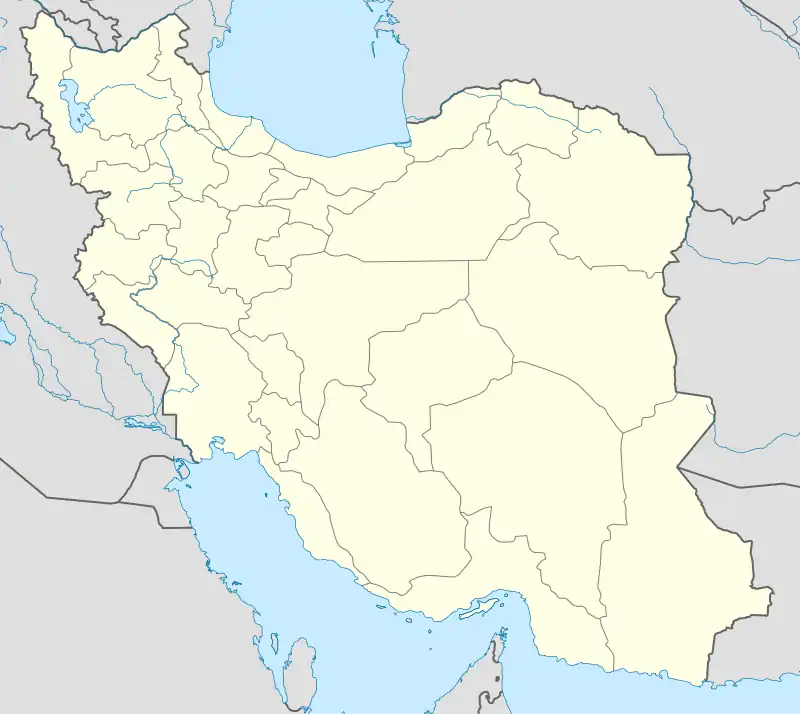Mahmuei
Persian: مهموئي | |
|---|---|
Village | |
 Mahmuei | |
| Coordinates: 33°19′40″N 59°20′58″E / 33.32778°N 59.34944°E[1] | |
| Country | |
| Province | South Khorasan |
| County | Birjand |
| District | Shakhenat |
| Rural District | Shakhenat |
| Population (2016)[2] | |
| • Total | 750 |
| Time zone | UTC+3:30 (IRST) |
Mahmuei (Persian: مهموئی) is a village in Shakhenat Rural District of Shakhenat District, Birjand County, South Khorasan province, Iran. According to legend, the first settlers named the village "Mahmûeî" because it was on open and flat ground. The word mahmuei is a derivation of the word mahmah which according to the Dehkhoda Dictionary means a flat plain.
Official statistics for Mahmuei in 1996 estimated a population of 695 people (185 houses and 223 families).[3] At the 2006 National Census, its population was 726 in 243 households, when it was in the Central District.[4] The following census in 2011 counted 860 people in 238 households.[5] The latest census in 2016 showed a population of 750 people in 221 households; it was the largest village in its rural district.[2]
After the census, the rural district and Shakhen Rural District were separated from the Central District to establish Shakhenat District.[6]
The inhabitants are Shiite Muslims speaking a local dialect of Persian. Most of the population is engaged in agriculture. Major products of Mahmuei are saffron (Za`ferân) and barberry (Zereshk) that are cultivated for exporting. Beet and wheat are cultivated as well. Grapes, black plume, apricots, melons, watermelons, almonds and pistachios are produced for local use. Before 1950, opium was also cultivated. Prior to digging the first deep well about 1980s, dry farming was the only agricultural method. Today, in addition to a string of underground aqueducts (Qanât), there are two networks of piped water and 23 electric and diesel deep wells for field irrigation.
Modern facilities include an electricity network since 1986, health-care, telephone (just one line since 1996,tel: +98 056 2533 -3400), drinking water since 1998, unrefined piped water, asphalt roads, a rural cooperative, an Islamic council, elementary school and a boarding middle school.
History
There is a shrine in the village cemetery where a pious man known as Âqâye Mîr-Abbâss, a descendant of Muhammad (Seyyed), was buried 70 years ago. The natives respect the shrine and dedicate money to it for obtaining their wants. About 1920s, at the time of making grape syrup (shîre-ye angoor) via boiling grape juice, somebody said to him "you are not a descendant of The Prophet." Mîr-Abbâss became annoyed and stepped into the huge fire that was lighted for boiling grape juices. He sat in the midst of the fireplace (Golkhan) to prove miraculously that he was a descendant of Muhammad. He stayed in the fireplace for a while and did not go out till some villagers entreated him to go out. After that event, the villagers believed and respected him and built a monument on his grave.[7]
Since 1950, many people emigrated from Mahmuei to city areas, especially to Tehran and Mashad. Many of these emigrants gather in the village during Muharram when a ceremony of Ta'zieh (Shabîh-khânî) is performed.
References
- ↑ OpenStreetMap contributors (18 March 2023). "Mahmuei, Birjand County" (Map). OpenStreetMap. Retrieved 18 March 2023.
- 1 2 "Census of the Islamic Republic of Iran, 1395 (2016)". AMAR (in Persian). The Statistical Center of Iran. p. 29. Archived from the original (Excel) on 17 October 2020. Retrieved 19 December 2022.
- ↑ .Ludwig W. Adamec, Historical Gazetteer of Iran. Vol.2, Meshed and Northeastern Iran. Graz:Academische Druck,1981.p.460
- ↑ "Census of the Islamic Republic of Iran, 1385 (2006)". AMAR (in Persian). The Statistical Center of Iran. p. 29. Archived from the original (Excel) on 20 September 2011. Retrieved 25 September 2022.
- ↑ "Census of the Islamic Republic of Iran, 1390 (2011)". Syracuse University (in Persian). The Statistical Center of Iran. p. 29. Archived from the original (Excel) on 20 January 2023. Retrieved 19 December 2022.
- ↑ Jahangiri, Ishaq (15 February 1400). "Letter of approval regarding country divisions in Birjand County, South Khorasan province". Qavanin (in Persian). Ministry of Interior, Council of Ministers. Archived from the original on 19 March 2023. Retrieved 19 March 2023.
- ↑ ."فرهنگ جغرافیایی ایران، آبادیها"، زیر نظر حسینعلی رزم آرا، تهران: سازمان جغرافیایی کشور، 1329، ج 9، ص 410


